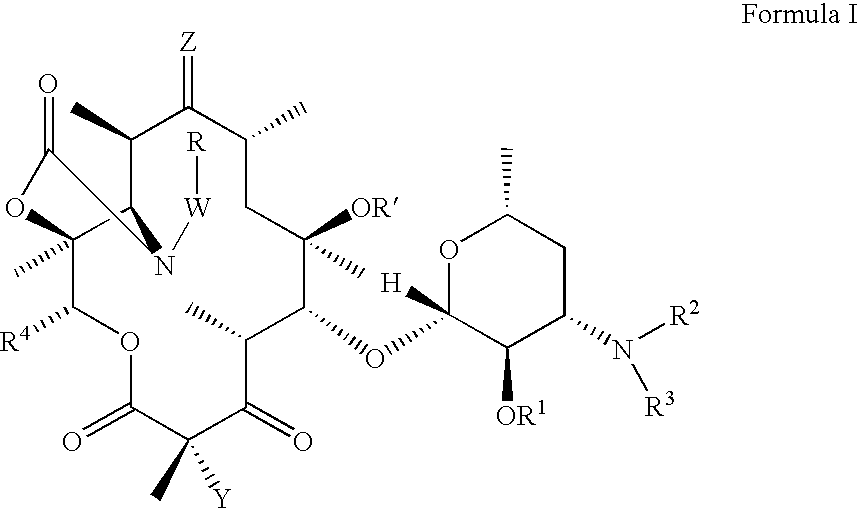Ketolide derivatives as antibacterial agents
a technology of ketolide and derivatives, applied in the field of ketolide derivatives, can solve the problems of poor local tolerance and poor absorption
- Summary
- Abstract
- Description
- Claims
- Application Information
AI Technical Summary
Benefits of technology
Problems solved by technology
Method used
Image
Examples
example 1
Preparation of 3-(4-pyridin-3-yl phenoxy) propan-1-amine
Step 1: Preparation of pyridin-3-boronic Acid
[0297]3-bromo pyridine (5 g) was dissolved in about 20 mL dry tetrahydrofuran and cooled to −78° C. Tri-isopropyl borate (14.6 mL) was added to the solution followed by adding butyl lithium (15% in hexane, 21 mL). The reaction mixture was stirred at −78° C. for about 4 hours, pH was adjusted to about 7, it was extracted with ethyl acetate and concentrated to yield white solid.
[0298]Yield: 1.2 g
Step 2: Preparation of 2-[3-(3-bromo-phenoxy)-propyl]-isoindole-1,3-dione
[0299]To 3-bromo phenol (0.03178 mol, 1 equiv.), about 30 mL of dry dimethylformamide was added and the solution was cooled to 0° C. Sodium hydride (0.0476 mol, 1.5 equiv.) was then added in portions. After 30 minutes, N-3-bromopropyl phthalimide (0.0381 mol, 1.2 equiv.) was added. The reaction mixture was stirred for about 3 hours and then quenched by pouring the reaction mixture into ice cold water. A precipitate thus fo...
example 2
Preparation of 4-(3H-imidazo[4,5-b]pyridin-3-yl)butan-1-amine
[0308]4-(3H-imidazo[4,5-b]pyridin-3-yl)butan-1-amine was prepared by following the procedure disclosed in U.S. Pat. No. 5,635,485, which is incorporated herein in its entirety. In particular, 10.3 g of potassium carbonate were added to a solution of 5.95 g of 4-azabenzimidazole and 15.5 g of N-4-bromobutyl-phthalimide in 30 mL of dimethylformamide and the mixture was stirred for 20 hours at ambient temperature. The insoluble part was filtered off and rinsed with methylene chloride. The organic phase was washed with water, dried over magnesium sulfate and evaporated. The oily residue obtained was washed with petroleum ether followed by isopropyl ether to yield 16.3 g of a yellow solid, which was purified by column chromatography on silica, eluting with a methylene chloride:acetone mixture to yield 4.9 g of a first product having a melting point at 143° C.
[0309]A mixture of 32.86 g of the first product obtained above, 697 mL...
example 3
Preparation of 3-isoquinolin-5-ylpropanal
Step I: Preparation of Dioxolane Derivative of Triphenylphosphorane
[0310]A solution of 2-bromomethyl-[1,3]dioxolane (60.0 mmol) and triphenylphosphine (60.0 mmol) in toluene (50 mL) was refluxed for 24 hours. A solid thus formed was filtered at room temperature, washed with diethyl ether and dried under reduced pressure to yield the title compound.
[0311]Yield: 3.5 g (54%)
[0312]M.P: 194-195° C.
Step II: Preparation of 5-[2-(1,3-dioxolan-2-yl)vinyl]isoquinoline
[0313]A solution of the Wittig salt (1.97 mmol) obtained in Step I and isoquinoline-2-carboxyaldehyde (7.97 mmol) (commercially available, Biocom) in about 20 mL of tetrahydrofuran was cooled to −35° C., potassium-t-butoxide (9.9 mmol) was added in portions, and the mixture was stirred at −35° C. for about 1 hour. The mixture was then warmed to 10° C., stirred for about 3 hours, poured into water and extracted with dichloromethane. The organic layer was dried over anhydrous sodium sulfate,...
PUM
| Property | Measurement | Unit |
|---|---|---|
| temperature | aaaaa | aaaaa |
| melting point | aaaaa | aaaaa |
| pH | aaaaa | aaaaa |
Abstract
Description
Claims
Application Information
 Login to View More
Login to View More - R&D
- Intellectual Property
- Life Sciences
- Materials
- Tech Scout
- Unparalleled Data Quality
- Higher Quality Content
- 60% Fewer Hallucinations
Browse by: Latest US Patents, China's latest patents, Technical Efficacy Thesaurus, Application Domain, Technology Topic, Popular Technical Reports.
© 2025 PatSnap. All rights reserved.Legal|Privacy policy|Modern Slavery Act Transparency Statement|Sitemap|About US| Contact US: help@patsnap.com



